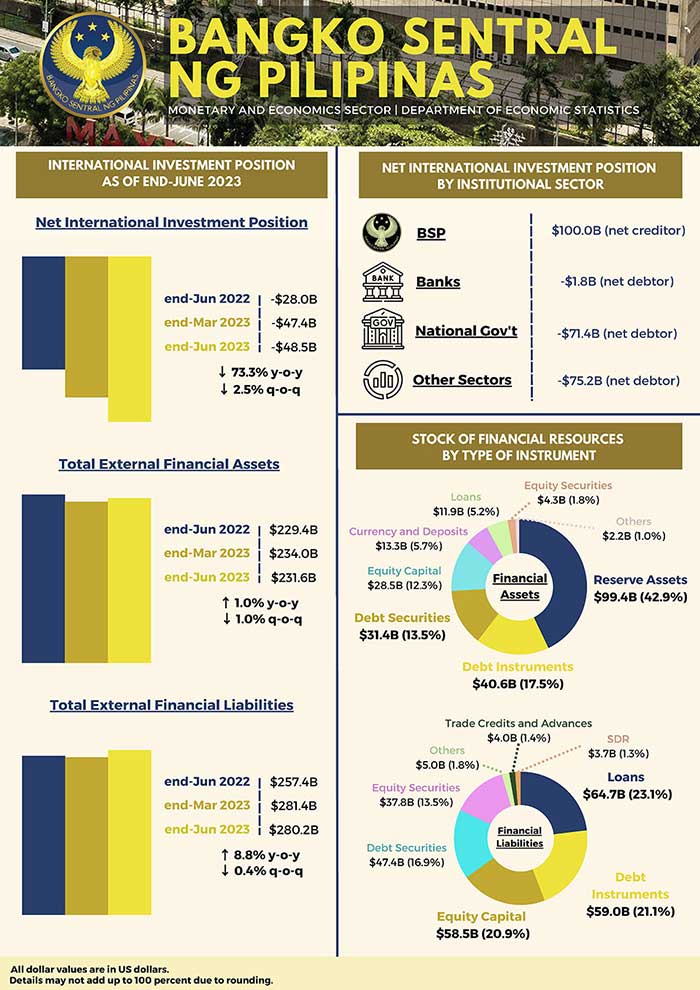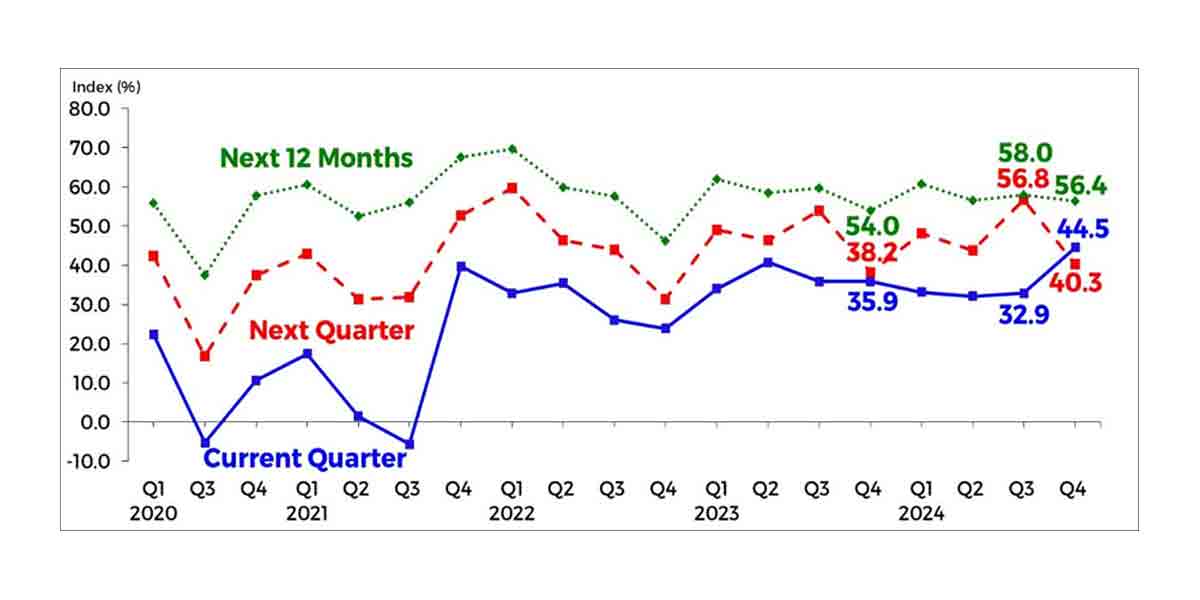
Second Quarter 2023 Developments
Preliminary data on the country’s net international investment position (IIP) indicated a net liability position of US$48.5 billion as of end-June 2023, slightly higher by 2.5 percent than the US$47.4 billion recorded in end-March 2023.
This development was driven mainly by the contraction in the country’s external financial assets (by 1.0 percent), which outpaced the decline in external financial liabilities (by 0.4 percent). As of end-June 2023, total outstanding external financial assets stood at US$231.6 billion, while total outstanding external financial liabilities amounted to US$280.2 billion.[1]
The quarter-on-quarter contraction in the country’s total stock of external financial assets emanated mainly from the decline in reserve assets to US$99.4 billion (from US$101.5 billion) and other investments to US$26.8 billion (from US$27.4 billion).
The level of reserves declined due to the National Government’s (NG) net foreign currency withdrawals from its deposits with the Bangko Sentral ng Pilipinas (BSP) to settle its foreign currency debt obligations and pay for its various expenditures, and downward adjustments in the valuation of the BSP’s foreign currency-denominated reserves (or non-gold reserves) and gold holdings.
In addition, the residents’ net withdrawal of their currency and deposits in foreign banks also contributed to the lower total outstanding level of external financial assets of the country during the review period.[2]
Meanwhile, the slight decrease in the country’s total stock of external financial liabilities during the quarter was due mainly to the 2.6 percent contraction in foreign portfolio investments (FPI) to US$85.2 billion (from US$87.4 billion) on account of downward valuation adjustments.
This decline, however, was muted partly by the 0.8 percent growth in foreign direct investments (FDI) to US$117.5 billion (from US$116.6 billion).
On a year-on-year basis, the country’s net external liability position rose by 73.3 percent from US$28.0 billion in end-June 2022. This was on account of the 8.8 percent growth in total external financial liabilities from US$257.4 billion, which more than offset the 1.0 percent growth in total external financial assets from US$229.4 billion.
The annual growth in the total external financial liabilities emanated mainly from the combined increases in the outstanding value of all components of the liability account.
In particular, FDI grew by 8.6 percent (to US$117.5 billion from US$108.2 billion) as intercompany borrowings from affiliates abroad increased by 10.7 percent (to US$59.0 billion).[3]
Other investments rose by 11.3 percent (to US$77.1 billion from US$69.3 billion) due to the 13.5 percent growth in residents’ outstanding loans (to US$64.7 billion). Further, FPI also increased by 6.9 percent (to US$85.2 from US$79.7 billion) as non-residents’ investments in resident-issued debt securities grew by 11.5 percent (to US$47.4 billion) during the review period.[4]
Meanwhile, the annual expansion in the total external financial assets reflected the residents’ direct investments abroad, particularly in the form of debt instruments (from US$38.0 billion to US$40.6 billion) and equity capital (from US$26.7 billion to US$28.5 billion).
External Financial Assets
The BSP continued to account for the largest share of residents’ total external financial claims at 44.8 percent, valued at US$103.8 billion as of end-June 2023. This, however, was 2.2 percent lower than the US$106.1 billion asset holdings registered in the previous quarter.
The Other Sectors’ outstanding external financial assets reached US$94.1 billion, accounting for 40.6 percent of the country’s total stock of financial assets as of end-June 2023.[5] The Banks accounted for the remaining 14.6 percent of the country’s total external financial assets, amounting to US$33.7 billion.
External Financial Liabilities
The Other Sectors contributed the largest share to the country’s total external liabilities at 60.5 percent or equivalent to US$169.4 billion as of end-June 2023. This level was 0.6 percent lower than the outstanding liabilities recorded in end-March 2023 at US$170.3 billion.
The NG, likewise, recorded a 0.6 percent decrease in its outstanding external financial liabilities to US$71.4 billion, which represents 25.5 percent of the Philippines’ total external financial liabilities. The Banks’ share accounted for 12.7 percent of the country’s total external financial liabilities at US$35.5 billion, higher by 0.6 percent than the US$35.3 billion in end-March 2023.
The remaining 1.4 percent or equivalent to US$3.8 billion of the country’s total external financial liabilities were held by the BSP.
View Full Report at https://www.bsp.gov.ph/Media_And_Research/International Investment Position/IIP2qtr2023.pdf
[1] The International Investment Position (IIP) is a statistical statement that shows at a point in time the value of financial assets of residents of an economy that are claims on non-residents or are gold bullion held as reserve assets and the liabilities of residents of an economy to non-residents. The difference between the assets and liabilities is the net position in the IIP and represents either a net claim on or a net liability to the rest of the world. (Source: Balance of Payments and International Investment Position Manual, 6th Edition). The current end-quarter net IIP is computed as follows: previous end-quarter net IIP plus current quarter Balance of Payments net flows and other changes (e.g., market price and exchange rate changes).
[2] The Central Bank is excluded from the Deposit-taking Corporations Sector.
[3] Debt instruments under the Direct Investment account consist mainly of intercompany borrowing/lending between direct investors and their subsidiaries/affiliates.
[4] Debt securities under the Portfolio Investment account consist mainly of placements in negotiable instruments serving as evidence of a debt, which are issued by enterprises that are not affiliated with the investors.
[5] Other Sectors cover the following economic sectors: (a) other financial corporations, which include private and public insurance corporations, holding companies, government financial institutions, investment companies, other financial intermediaries except insurance, trust institutions/corporations, financing companies, securities dealers/brokers, lending investor, Authorized Agent Banks (AAB) forex corporations, investment houses, pawnshops, credit card companies, offshore banking units (OBUs); (b) non-financial corporations, which refer to public and private corporations and quasi-corporations, whose principal activity is the production of market goods or non-financial services; and (c) households and non-profit institutions serving households (NPISHs).





















